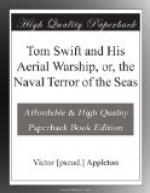Dropping bombs from an aeroplane, or a dirigible balloon, is a comparatively simple matter. Of course there are complications that may ensue, from the danger of carrying high explosives in the limited quarters of an airship, with its inflammable gasoline fuel, and ever-present electric spark, to the possible premature explosion of the bomb itself. But they seem to be considered minor details now.
On the other hand, while it is comparatively easy to drop a bomb from a moving aeroplane, or dirigible balloon, it is another matter to make the bomb fall just where it will do the most damage to the enemy. It is not easy to gauge distances, high up in the air, and then, too, allowance must be made for the speed of the aircraft, the ever-increasing velocity of a falling body, and the deflection caused by air currents.
The law of velocity governing falling bodies is well known. It varies, of course, according to the height, but in general a body falling freely toward the earth, as all high-school boys know, is accelerated at the rate of thirty-two feet per second. This law has been taken advantage of by the French in the present European war. The French drop from balloons, or aeroplanes, a steel dart about the size of a lead pencil, and sharpened in about the same manner. Dropping from a height of a mile or so, that dart will acquire enough velocity to penetrate a man from his head all the way through his body to his feet.
But in dropping bombs from an airship the damage intended does not so much depend on velocity. It is necessary to know how fast the bomb falls in order to know when to set the time fuse that will explode it; though some bombs will explode on concussion.
At aeroplane meets there are often bomb-dropping contests, and balls filled with a white powder (that will make a dust-cloud on falling, and so show where they strike) are used to demonstrate the birdman’s accuracy.
“We’ll see how our bomb-release works,” Tom went on. “But we’ll have to descend a bit in order to watch the effect.”
“You’re not going to use real bombs, are you, Tom?” asked Ned.
“Indeed not. Just chalk-dust ones for practice. Now here is where the bombs will be placed,” and he pointed to the three openings in the floor of the amidship cabin. The wire nettings were taken out and one could look down through the holes to the earth below, the ground being nearer now, as Tom had let out some of the lifting gas.
“Here is the range-finder and the speed calculator,” the young inventor went on as he indicated the various instruments. “The operator sits here, where he can tell when is the most favorable moment for releasing the bomb.”
Tom took his place before a complicated set of instruments, and began manipulating them. One of his assistants, under the direction of Lieutenant Marbury, placed in the three openings bombs, made of light cardboard, just the size of a regular bomb, but filled with a white powder that would, on breaking, make a dust-cloud which could be observed from the airship.




